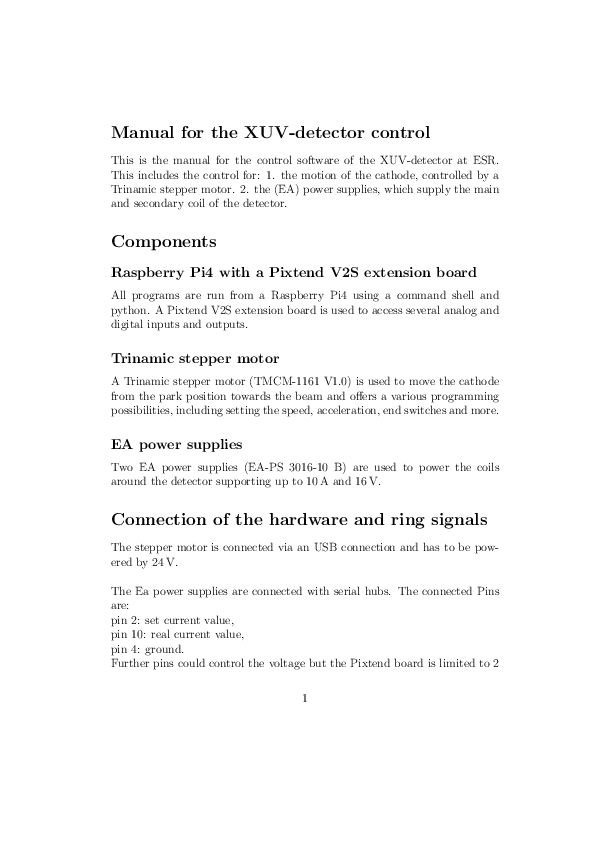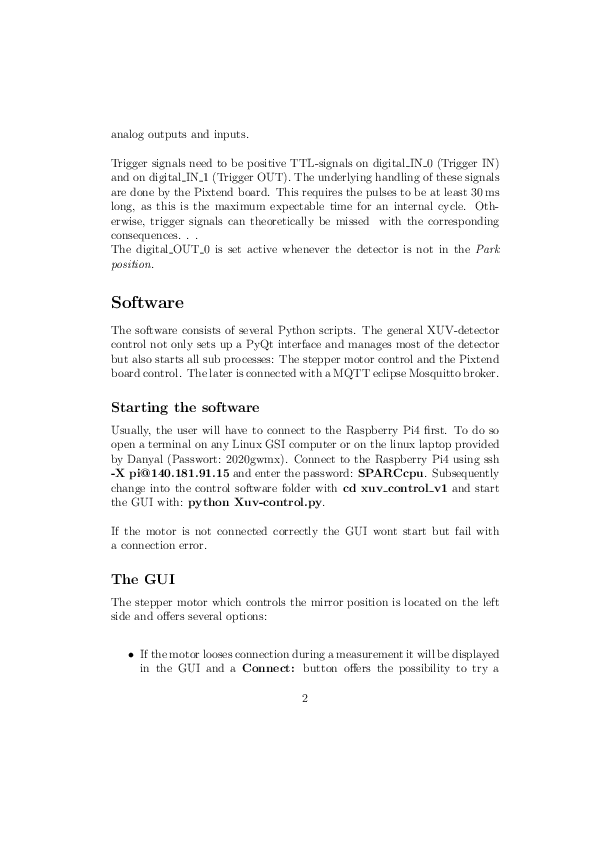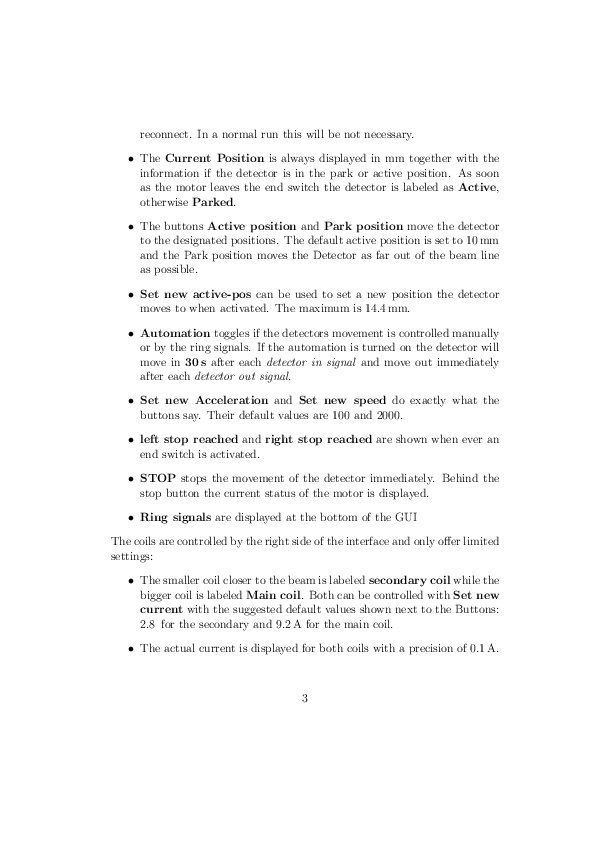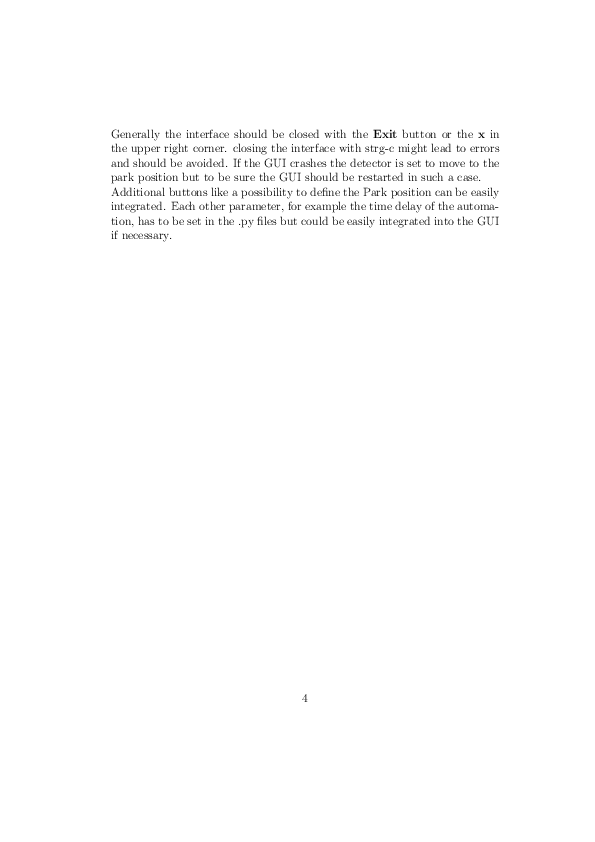| ID |
Date |
Author |
Category |
Subject |
|
62
|
Sat May 15 06:51:16 2021 |
Night Shift Sebastian/Max/Noah | General | Different Laserscantypes |
We use different scan types (manual scan) or constant laser wavelengths to check the effects of laser cooling in the Schottky diagrams (fluorescence can not be seen in the detector), for different bunching amplitudes and frequencies:
- Scan from 1028.950 -> 1028.940, stepsize 0.001 every 10 sec
- Scan from 1028.950 -> 1028.930, stepsize 0.001 every 5 sec
- Scan from 1028.950 -> 1028.940 -> 1029.950, stepsize 0.001 every 5 sec
- Scan from 1028.950 -> 1028.940, stepsize 0.0005 "as fast as possible"
- constant wavelengths around 1028.940
- Scan to wavelengths < 1028.940 (heating) -> Jump to 1028.945 and fast scan back to 1028.940 (-> cooling)
The cooling effects of the laser can be observed well in the Schottky spectra :) |
|
67
|
Sat May 15 11:06:31 2021 |
Benedikt | General | New Zoom link for the moment |
https://tu-darmstadt.zoom.us/j/4948400422?pwd=SEJaUzBuYXM0TTd6UWxoZTFlWEZxUT09
Meeting ID: 494 840 0422
Passcode: 215586 |
|
68
|
Sat May 15 11:26:44 2021 |
Benedikt | General | TEM parameters |
We changed the horizontal position of the laser beam a bit, so that we maximized the fluorescence signal on the XUV detector (coasting beam, scanning laser (0.03 Hz)).
Old parameters: OffsetM Ax 0.00; Bx 0.00; Ay -0.08; By -0.40
New parameters: OffsetM Ax 0.00; Bx 0.35; Ay -0.08; By -0.40 |
|
69
|
Sat May 15 12:11:54 2021 |
Benedikt | General | Laser-bunch-timing |
Optimizing the laser bunch timing.
h = 7 (9.0389145 MHz)
Reprate is already set to same frequency.
Results: For h=7:
4 ns delay results in a maximum fluorescence rate in the XUV detector
25 ns delay shows the highest intensity in the Schottky spectrum while the laser operates at 1028.940 nm. |
|
70
|
Sun May 16 02:18:53 2021 |
Sebastian | General | UV Drop |
1:25 a.m. huge drop in UV laser power
-> small crystal bump with both y screws of bbo oven |
|
Draft
|
Sun May 16 02:20:58 2021 |
Sebastian | General | "Der Laser ist (wieder) ok" |
|
|
72
|
Sun May 16 02:22:19 2021 |
Sebastian | General | "Der Laser ist ok" |
|
|
73
|
Sun May 16 02:28:21 2021 |
Team | General | #Beam ON! |
Laser specs:
pulse length -> 482ps
~75mW UV Power inside ESR (depending on laser wavelength) |
|
74
|
Sun May 16 05:09:04 2021 |
Team | General | Laser cooling with 482ps |
we see laser cooling with 482ps pulse length |
|
75
|
Sun May 16 05:09:27 2021 |
Team | General | Switch to 285ps |
pulse length -> 285ps
minimum 62mW inside ESR (depending on laser wavelength) |
|
76
|
Sun May 16 05:24:00 2021 |
Team | General | Laser cooling with 285ps |
we also see laser cooling with 285ps pulse length |
|
77
|
Sun May 16 06:13:46 2021 |
Team | General | Switch to 166ps |
|
|
78
|
Sun May 16 07:03:07 2021 |
Team | General | Laser cooling with 166ps |
We saw some indications of laser cooling @ 166ps pulse length |
|
79
|
Sun May 16 07:18:56 2021 |
Night Shift Sebastian/Max/Noah | General | Preparation for automated laser scans |
We shut the laser system down to prepare automated laser scans |
|
80
|
Sun May 16 11:29:22 2021 |
Benedikt | General | Automated laser scans working |
The automated laser scans are working now.
We can now scan with the following functions: triangle, sawtooth, cosinus/sinus, arctan, min (linear scan, than stands still)
We are now testing these scan functions with coasting beams; ecooler 10 mA. |
|
81
|
Sun May 16 21:23:02 2021 |
Team | General | ESR OPEN -> preparation for Polarisation Tests |
|
|
82
|
Sun May 16 22:11:49 2021 |
Team | General | Laser Polarisation values |
maximal transmission of PBSC (257/514 pbsc was used in combination with xlp12 detector and visual on a screen):
L/4 @ 276° & L/2 @ 348° --> p-polarized light
L/4 gleich auf 276° & L/2 auf ~19° --> s-polarized light
current position 22:15 p.m.
now we have some fun ! :D |
|
83
|
Mon May 17 08:05:42 2021 |
Team | General | End of beamtime |
~ 8 a.m. |
|
84
|
Mon May 17 21:43:56 2021 |
Danyal | General | The test beamtime was a success. |
Dear all,
The test beamtime is now over.
We had 6 days of Li-like carbon in the ESR (122 MeV/u).
Effectively, we could measure almost 5 days continuously.
There were only a few interruptions, one of which was a longer power failure.
The vacuum in the ESR was not optimal, which strongly reduced the lifetime of the stored ion beam (~30 s)
and the electron cooler showed weird instabilities, which need to be clarified still.
Still, we were able to cover all aspects of the program.
Essentially everything we tried worked.
Therefore, I conclude that it was a great success.
Many thanks to all who have contributed to it!
Special thanks to Sebastian and Benedikt - who worked really hard during the last months - for prepapring the laser system and the data acquisition system.
Also special thanks to Volker and Ken for preparing the XUV detector system.
We will start sorting/ordering & filtering the data soon and will invite for a meeting where we present the raw data so that we can discuss it.
Then we will also discuss the next big step: data analysis.
Of course it is our next objective (with high priority) to publish the analyzed data in foreseeable time.
I hope to see you soon.
Until then, take care and stay healthy,
Danyal |
|
4
|
Tue May 11 16:33:31 2021 |
Ken Ueberholz | Detectors | Detector control manual |
Attached to this elog entry is a short manual for the xuv-detector control. If anything is missing or not understandable I can change anything. |
| Attachment 1: Manual.pdf
|




|